- Home
- Semester and Timetable Information
- Study Physics
- Our Research
- Our People
- Careers and Alumni
- Seminars, News and Events
- Outreach and School Resources
- About the School
- What is Physics
- The Crawford Observatory
- Frequently Asked Questions
- MBH Conference
- UCC Futures Quantum & Photonics
- Supports
Seminars 2021/2022
Jerry Moloney, 3rd June, 2022
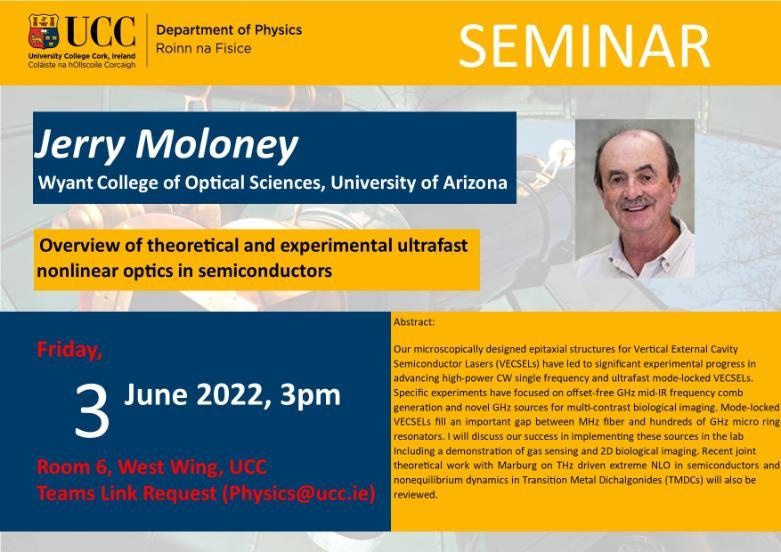
| Seminar Speaker: | Jerry Moloney |
|---|---|
| Venue: |
Room 6, West Wing, UCC Teams: https://teams.microsoft.com/l/meetup-join/19%3ameeting_OGRmMWY4OGQtZjJjOC00MzM2LWIxOWQtNzhjNDEwYzIwZDhl%40thread.v2/0?context=%7b%22Tid%22%3a%2246fe5ca5-866f-4e42-92e9-ed8786245545%22%2c%22Oid%22%3a%22b65f1146-f95a-4db5-8cc4-e480f330744d%22%2c%22IsBroadcastMeeting%22%3atrue%7d&btype=a&role=a |
| Time and Date: | Friday, 3rd June, 2022, 3pm |
| Title: |
Overview of theoretical and experimental ultrafast nonlinear optics in semiconductors
|
| Abstract: Our microscopically designed epitaxial structures for Vertical External Cavity Semiconductor Lasers (VECSELs) have led to significant experimental progress in advancing high-power CW single frequency and ultrafast mode-locked VECSELs. Specific experiments have focused on offset-free GHz mid-IR frequency comb generation and novel GHz sources for multi-contrast biological imaging. Mode-locked VECSELs fill an important gap between MHz fiber and hundreds of GHz micro ring resonators. I will discuss our success in implementing these sources in the lab including a demonstration of gas sensing and 2D biological imaging. Recent joint theoretical work with Marburg on THz driven extreme NLO in semiconductors and nonequilibrium dynamics in Transition Metal Dichalgonides (TMDCs) will also be reviewed.
|
|---|
Shane O Mahony, 4th April, 2022
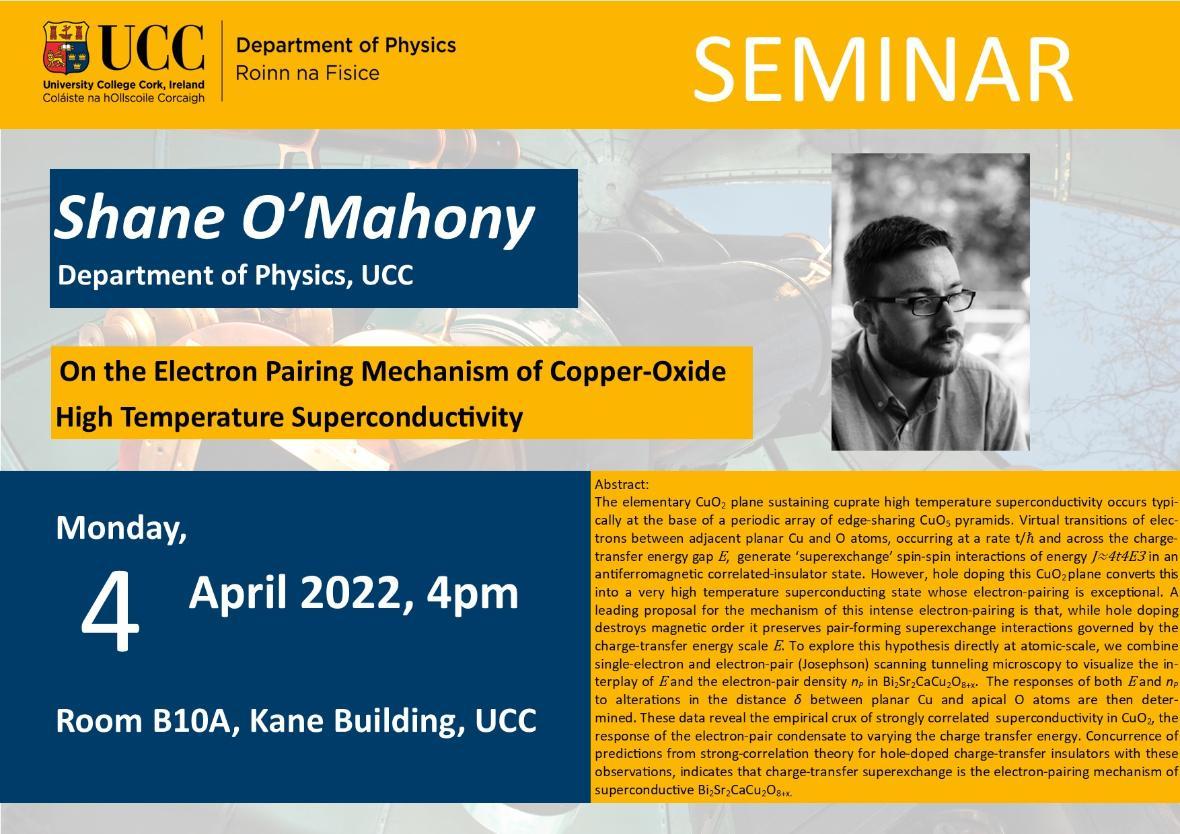
| Seminar Speaker: | Shane O Mahony |
|---|---|
| Venue: |
Room B10A, Kane Buidling, UCC |
| Time and Date: | Monday, 4th April, 2022, 4pm |
| Title: |
On the Electron Pairing Mechanism of Copper-Oxide High Temperature Superconductivity
|
| Abstract: The elementary CuO2 plane sustaining cuprate high temperature superconductivity occurs typically at the base of a periodic array of edge-sharing CuO5 pyramids. Virtual transitions of electrons between adjacent planar Cu and O atoms, occurring at a rate t/ℏ and across the charge-transfer energy gap E, generate ‘superexchange’ spin-spin interactions of energy J≈4t4E3 in an antiferromagnetic correlated-insulator state. However, hole doping this CuO2 plane converts this into a very high temperature superconducting state whose electron-pairing is exceptional. A leading proposal for the mechanism of this intense electron-pairing is that, while hole doping destroys magnetic order it preserves pair-forming superexchange interactions governed by the charge-transfer energy scale E. To explore this hypothesis directly at atomic-scale, we combine single-electron and electron-pair (Josephson) scanning tunneling microscopy to visualize the interplay of E and the electron-pair density nP in Bi2Sr2CaCu2O8+x. The responses of both E and nP to alterations in the distance δ between planar Cu and apical O atoms are then determined. These data reveal the empirical crux of strongly correlated superconductivity in CuO2, the response of the electron-pair condensate to varying the charge transfer energy. Concurrence of predictions from strong-correlation theory for hole-doped charge-transfer insulators with these observations, indicates that charge-transfer superexchange is the electron-pairing mechanism of superconductive Bi2Sr2CaCu2O8+x.
|
|---|
Dr. Vladimir M. Stojanović, 23rd March, 2022
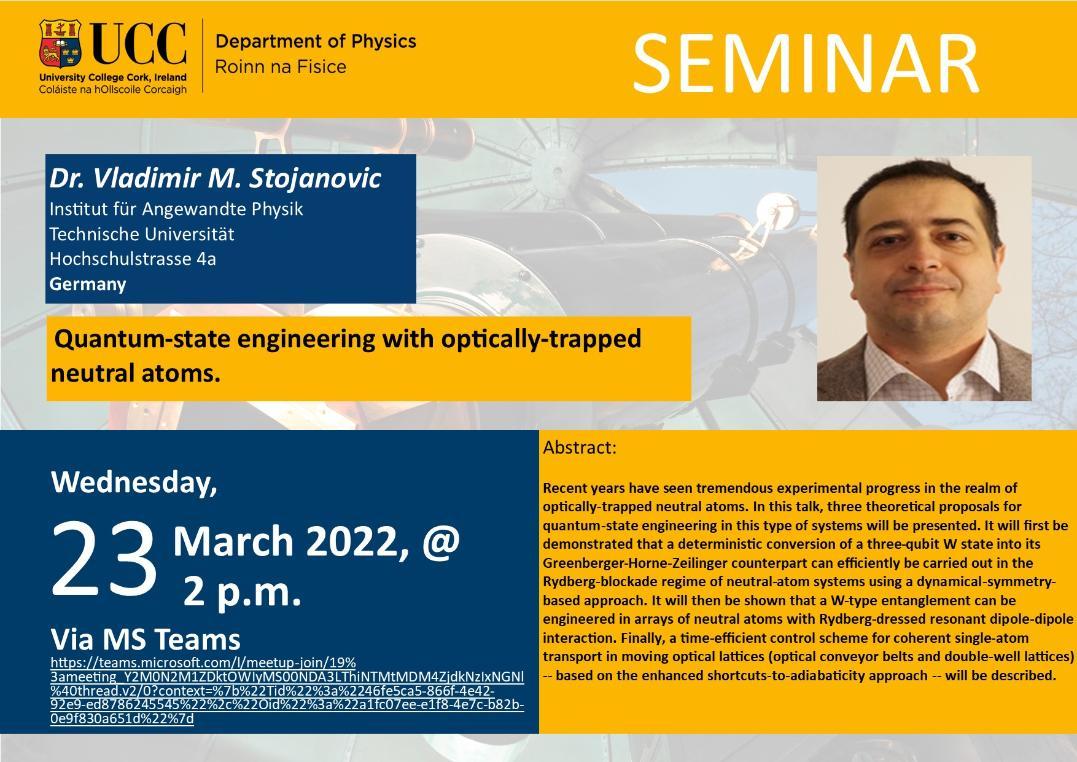
| Seminar Speaker: | Dr. Vladimir M. Stojanović |
|---|---|
| Venue: |
|
| Time and Date: | Wednesday, 23rd March 2022 @ 14:00pm |
| Title: | Quantum-state engineering with optically-trapped neutral atoms |
| Abstract: Recent years have seen tremendous experimental progress in the realm of optically-trapped neutral atoms. In this talk, three theoretical proposals for quantum-state engineering in this type of systems will be presented. It will first be demonstrated that a deterministic conversion of a three-qubit W state into its Greenberger-Horne-Zeilinger counterpart can efficiently be carried out in the Rydberg-blockade regime of neutral-atom systems using a dynamical-symmetry-based approach. It will then be shown that a W-type entanglement can be engineered in arrays of neutral atoms with Rydberg-dressed resonant dipole-dipole interaction. Finally, a time-efficient control scheme for coherent single-atom transport in moving optical lattices (optical conveyor belts and double-well lattices) -- based on the enhanced shortcuts-to-adiabaticity approach -- will be described. |
|---|
Felix Pötzl, 14th March, 2022

| Seminar Speaker | Felix Pötzl |
|---|---|
| Venue | Room B10A, Kane Building, UCC |
| Time and Date | Monday, March 14th - 4pm |
| Title | New perspectives of VLBI on observing jets in active galactic nuclei |
| Abstract | In this talk I will present the state-of-the art and future perspectives of observations of active galactic nuclei (AGN) with high-resolution very-long-baseline interferometry (VLBI). This technology enables the observation of the central acceleration and collimation zone of parsec-scale jets in AGN. A lot of open questions remain on how these jets are formed, and via which mechanisms particles are accelerated and the jets collimated up to kiloparsec-scale distances. To address these questions, I will highlight results from both the latest space-borne VLBI mission RadioAstron, as well as short-wavelength observations culminating in the latest efforts of the event horizon telescope (EHT) collaboration. I will also discuss a new project to determine magnetic field profiles along AGN jets with high-frequency phase-referencing observations, which could put some constrains on the nature of the jet launching region. |
Amy Marconnet, 28th February, 2022
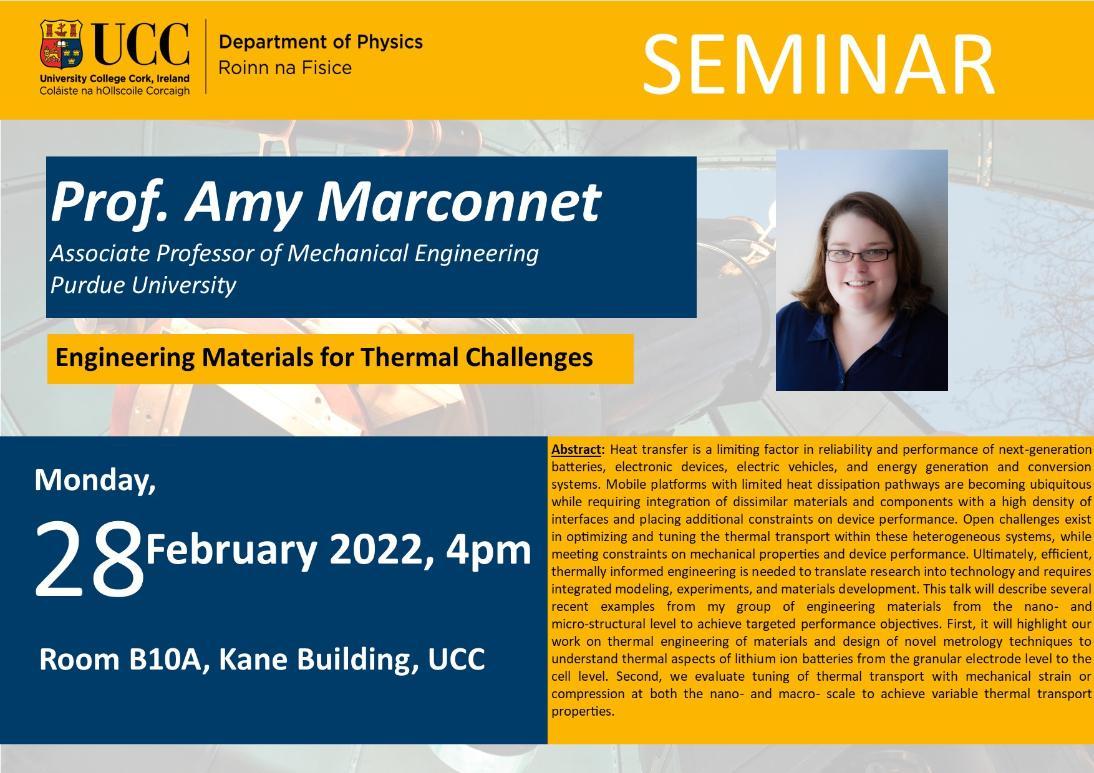
| Seminar Speaker: | Amy Marconnet, Purdue University - https://engineering.purdue.edu/MTEC/contact |
|---|---|
| Venue: | Kane Buidling UCC |
| Time and Date: | Monday, February 28th, 2022 - 4pm |
| Title: | Engineering Materials for Thermal Challenges |
| Abstract: Heat transfer is a limiting factor in reliability and performance of next-generation batteries, electronic devices, electric vehicles, and energy generation and conversion systems. Mobile platforms with limited heat dissipation pathways are becoming ubiquitous while requiring integration of dissimilar materials and components with a high density of interfaces and placing additional constraints on device performance. Open challenges exist in optimizing and tuning the thermal transport within these heterogeneous systems, while meeting constraints on mechanical properties and device performance. Ultimately, efficient, thermally informed engineering is needed to translate research into technology and requires integrated modeling, experiments, and materials development. This talk will describe several recent examples from my group of engineering materials from the nano- and micro-structural level to achieve targeted performance objectives. First, it will highlight our work on thermal engineering of materials and design of novel metrology techniques to understand thermal aspects of lithium ion batteries from the granular electrode level to the cell level. Second, we evaluate tuning of thermal transport with mechanical strain or compression at both the nano- and macro- scale to achieve variable thermal transport properties. |
|---|
Michael Tremmel, 21st February, 2022
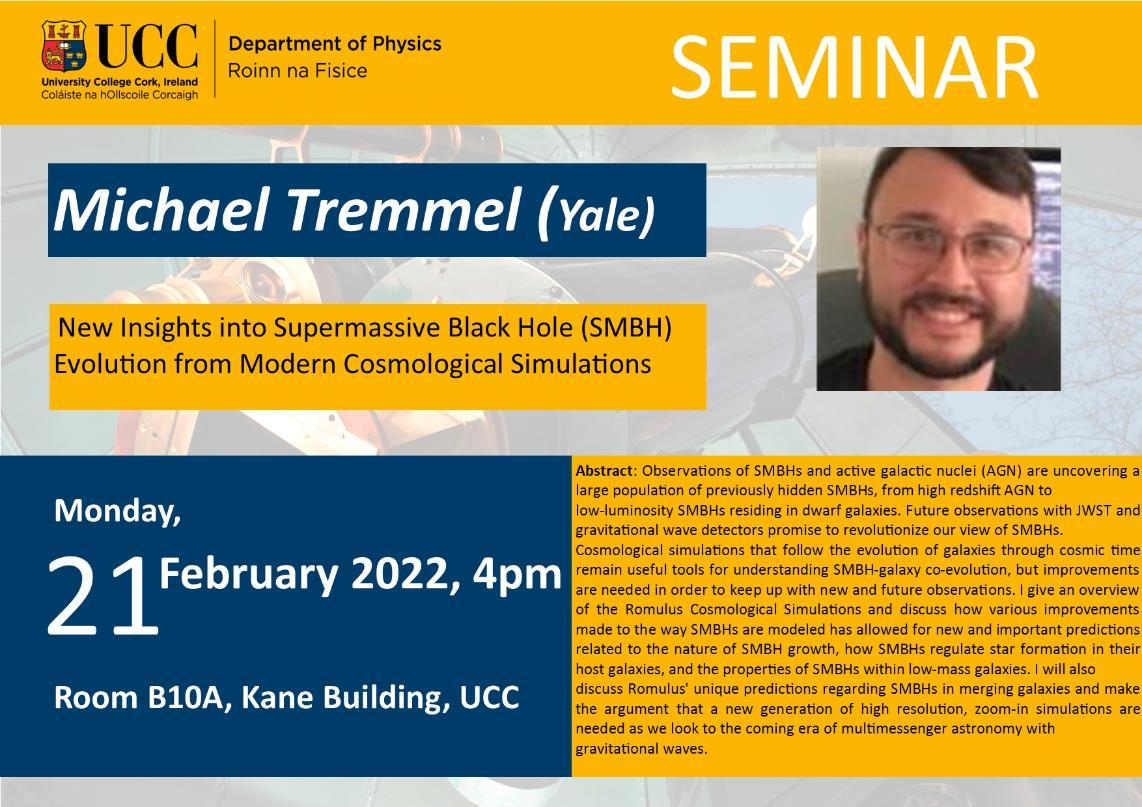
| Seminar Speaker | Michael Tremmel |
|---|---|
| Venue | Room B10A, Kane Building, UCC |
| Time and Date | Monday, February 21st - 4pm |
| Title | New Insights into Supermassive Black Hole (SMBH) Evolution from Modern Cosmological Simulations |
| Abstract | Observations of SMBHs and active galactic nuclei (AGN) are uncovering a large population of previously hidden SMBHs, from high redshift AGN to low-luminosity SMBHs residing in dwarf galaxies. Future observations with JWST and gravitational wave detectors promise to revolutionize our view of SMBHs. Cosmological simulations that follow the evolution of galaxies through cosmic time remain useful tools for understanding SMBH-galaxy co-evolution, but improvements are needed in order to keep up with new and future observations. I give an overview of the Romulus Cosmological Simulations and discuss how various improvements made to the way SMBHs are modeled has allowed for new and important predictions related to the nature of SMBH growth, how SMBHs regulate star formation in their host galaxies, and the properties of SMBHs within low-mass galaxies. I will also discuss Romulus' unique predictions regarding SMBHs in merging galaxies and make the argument that a new generation of high resolution, zoom-in simulations are needed as we look to the coming era of multimessenger astronomy with gravitational waves. |
Cornelia C. Lang, 28th January, 2022
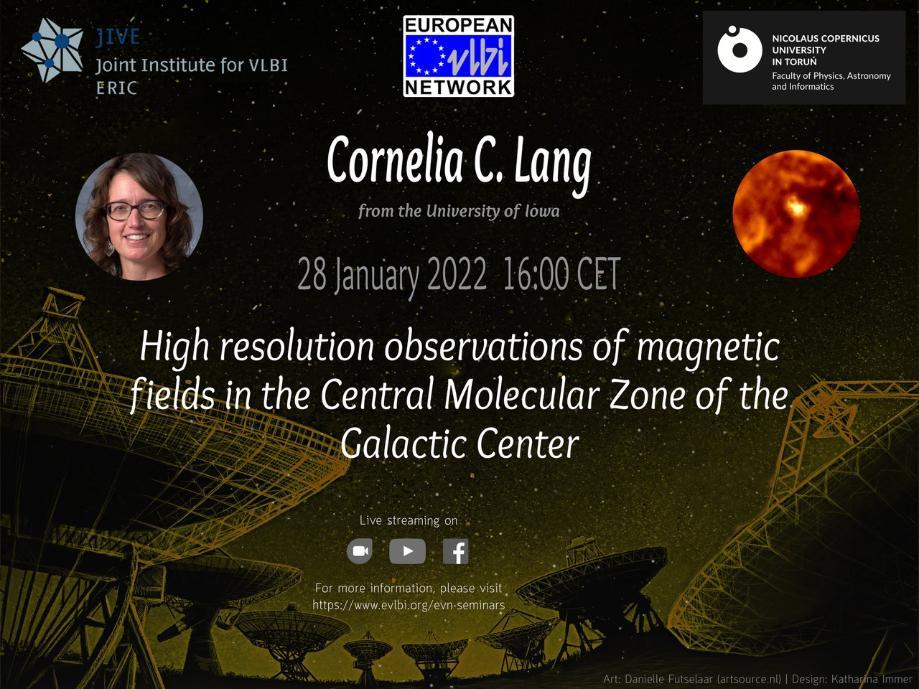
This will be a "shared" online talk which is also part of the virtual seminar series "The sharpest view of the Radio Universe" (EVN e-seminar series, https://www.evlbi.org/evn-seminars , organising committee chaired by Denise Gabuzda (UCC Physics) ):
| Seminar Speaker: | Cornelia C. Lang, University of Iowa |
|---|---|
| Venue: | Watch Recording on the YouTube the JIVE and EVN channel: JIVE and the EVN - YouTube |
| Time and Date: | Friday 28th January |
| Title: | High resolution observations of magnetic fields in the Central Molecular Zone of the Galactic Center |
| Abstract: In addition to harboring a supermassive black hole at its very core, the Galactic center is one of the most physically extreme environments in the Galaxy. Dense and massive molecular clouds on non-circular orbits are abundant in this region, yet star formation is not as active and frequent as expected. In addition, radio observations have revealed a population of synchrotron-emitting filaments that provide insight on the magnetic field strength and configuration in this unique region of the Galaxy. I will review observational results from several recent studies undertaken by my research group: we have examined the properties and kinematics of a group of unusual molecular clouds that appear to be part of an orbital “stream” of material around the Galactic center. In addition, we have been studying the detailed structure of the synchrotron-emitting radio filaments and their connection to larger-scale energetic outflows from the Galactic center. Our relative proximity to the Galactic center provides an unprecedented view of a galactic core and studies of this region can be used as an astrophysical analog to understanding the nuclei of more distant galaxies. |
|---|
Giuseppe Cimò, 29th November, 2021

This will be a "shared" online talk which is also part of the virtual seminar series "The sharpest view of the Radio Universe" (EVN e-seminar series, https://www.evlbi.org/evn-seminars , organising committee chaired by Denise Gabuzda (UCC Physics) ):
| Seminar Speaker: | Giuseppe Cimò |
|---|---|
| Venue: | Attendants can join via Zoom following this link (Meeting ID: 885 4531 2932) https://astron.zoom.us/j/88545312932 The talk will also be streamed in real time via YouTube in the JIVE and EVN channel: https://www.youtube.com/watch?v=j5gyOqubwVs |
| Time and Date: | 3pm, Monday 29th November |
| Title: | Observing interplanetary spacecraft with radio telescopes: connecting astronomers and space scientists |
| Abstract: Observations of human-made satellites using arrays of radio telescopes can provide the ultra-precise determination of their speed and their position on the celestial sphere. The Planetary Radio Interferometry and Doppler Experiment (PRIDE) is a technique that connects ground-based radio astronomy and space science to deliver the sharpest view of spacecraft in our solar system. PRIDE's precise determination of the lateral position of spacecraft can be used for a variety of scientific applications, including improvement of ephemerides, ultra-precise celestial mechanics of planetary systems, gravimetry, spacecraft orbit determination, and fundamental physics. Furthermore, observations of the radio signal transmitted by a spacecraft are an important source of information on interplanetary plasma and solar wind. In this talk, I will present novel results of observing ESA and NASA spacecraft with ground-based radio telescopes and demonstrate the capabilities of such a technique. |
|---|
Dr. Mark Kennedy, 1st November 2021
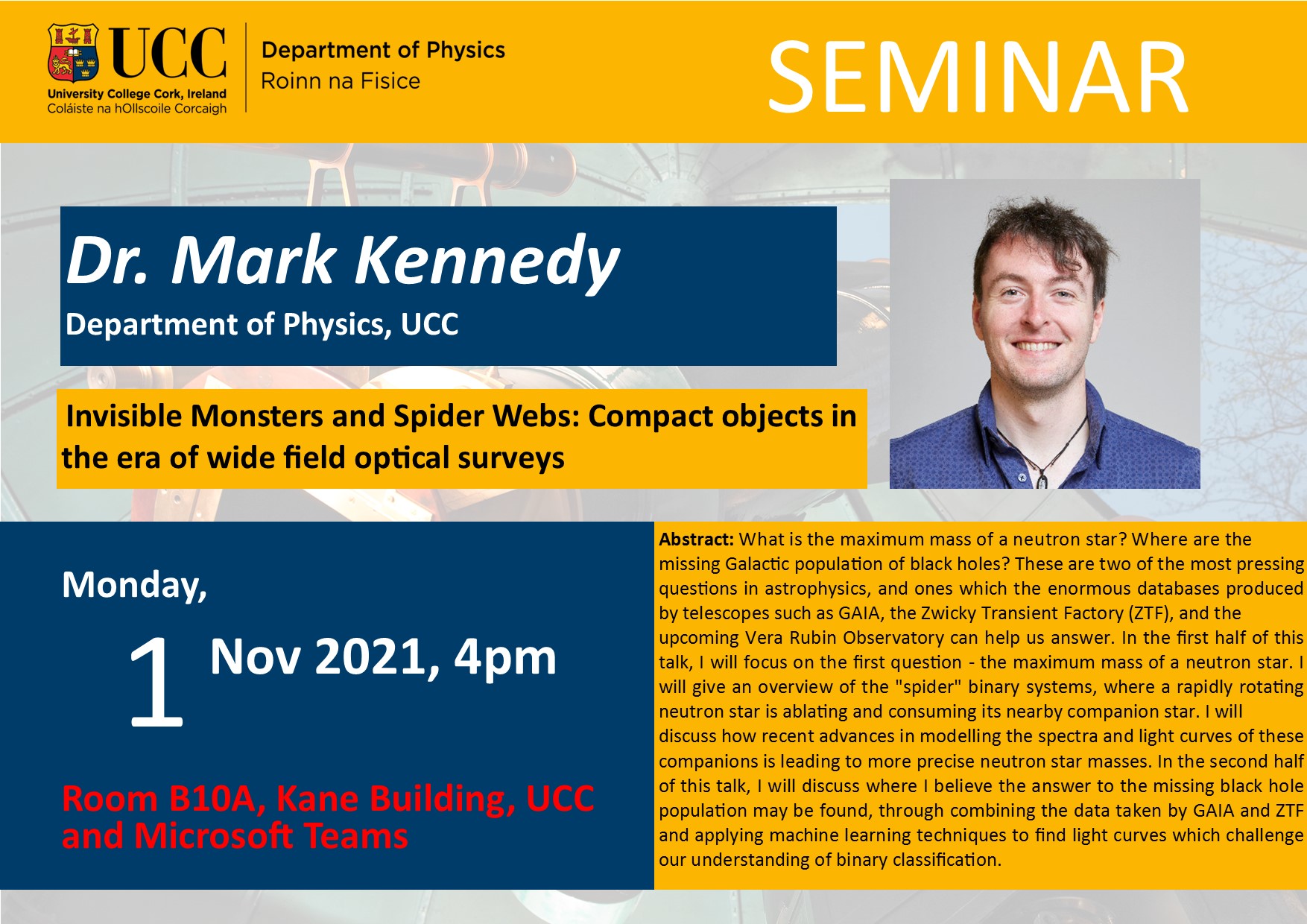
| Seminar Speaker: | Dr Mark Kennedy |
|---|---|
| Venue: | Room B10A, Kane Building, UCC (Seats offered on a first come, first served basis) |
| Date and Time: | 1st November, 2021 - 4pm |
| Seminar Title: | Invisible Monsters and Spider Webs: Compact objects in the era of wide field optical surveys |
| Abstract: What is the maximum mass of a neutron star? Where are the missing Galactic population of black holes? These are two of the most pressing questions in astrophysics, and ones which the enormous databases produced by telescopes such as GAIA, the Zwicky Transient Factory (ZTF), and the upcoming Vera Rubin Observatory can help us answer. In the first half of this talk, I will focus on the first question - the maximum mass of a neutron star. I will give an overview of the "spider" binary systems, where a rapidly rotating neutron star is ablating and consuming its nearby companion star. I will discuss how recent advances in modelling the spectra and light curves of these companions is leading to more precise neutron star masses. In the second half of this talk, I will discuss where I believe the answer to the missing black hole population may be found, through combining the data taken by GAIA and ZTF and applying machine learning techniques to find light curves which challenge our understanding of binary classification. |
|
Dr. Fatima Gunning, 11th October 2021
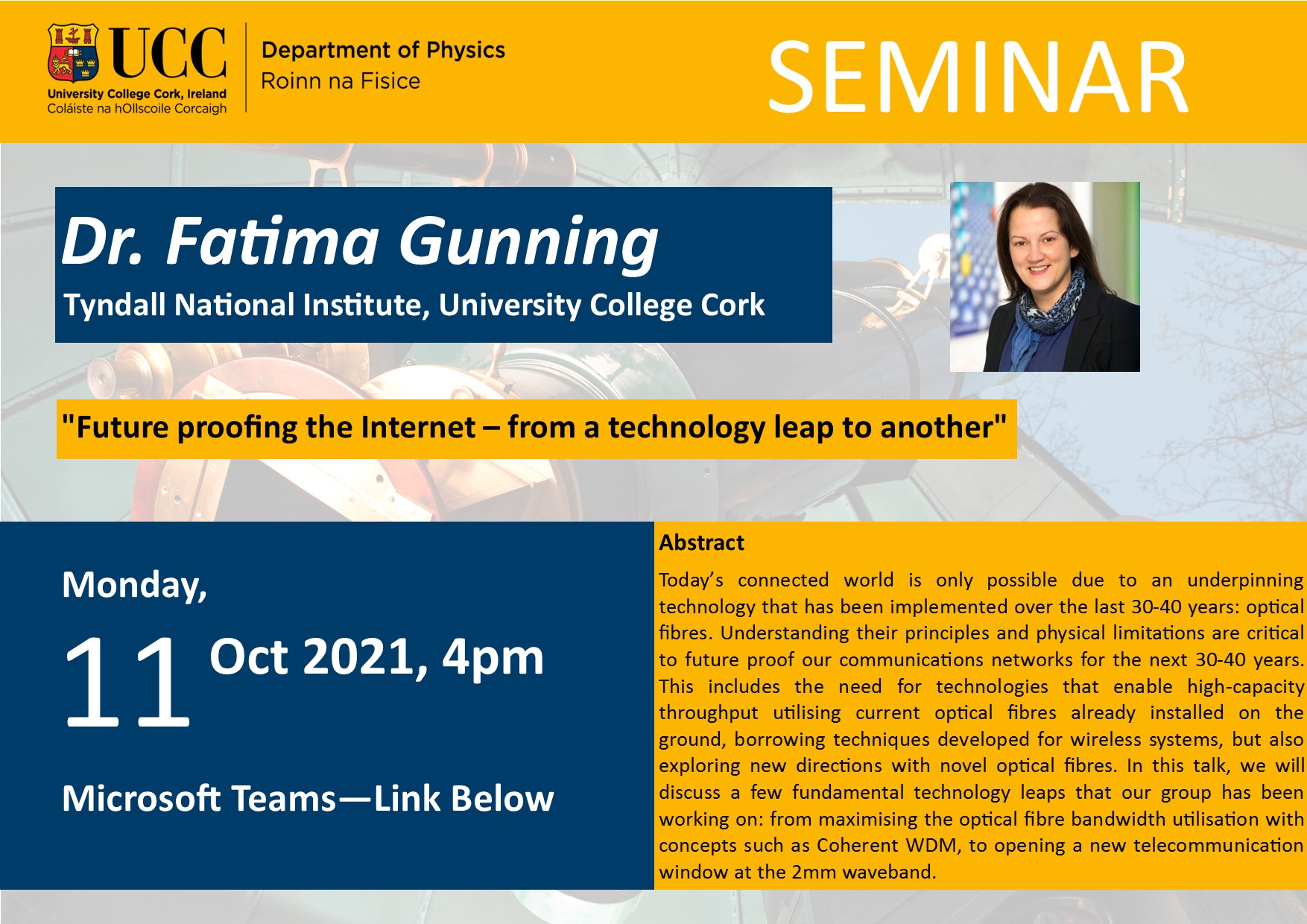
| Seminar Speaker: |
Dr. Fatima Gunning |
|---|---|
| Venue: | Link for joining the talk via Microsoft Teams: https://teams.microsoft.com/l/meetup-join/19%3ameeting_MTFhN2QzZjMtN2M5NC00OGY5LWEzY2MtZWNhM2UwMDY1NmI1%40thread.v2/0?context=%7b%22Tid%22%3a%2246fe5ca5-866f-4e42-92e9-ed8786245545%22%2c%22Oid%22%3a%22a1fc07ee-e1f8-4e7c-b82b-0e9f830a651d%22%7d |
| Date and Time: | 11th October 2021 |
| Seminar Title: | "Future proofing the Internet – from a technology leap to another" |
| Abstract: Today’s connected world is only possible due to an underpinning technology that has been implemented over the last 30-40 years: optical fibres. Understanding their principles and physical limitations are critical to future proof our communications networks for the next 30-40 years. This includes the need for technologies that enable high-capacity throughput utilising current optical fibres already installed on the ground, borrowing techniques developed for wireless systems, but also exploring new directions with novel optical fibres. In this talk, we will discuss a few fundamental technology leaps that our group has been working on: from maximising the optical fibre bandwidth utilisation with concepts such as Coherent WDM, to opening a new telecommunication window at the 2mm waveband. |
|---|
